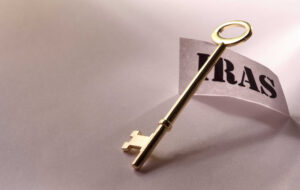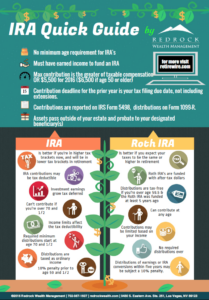
IRA’s were created over 40 years ago back in 1974 under ERISA (Employee Retirement Income Security Act). With over 30 million households and 7.4 trillion dollars in individual retirement accounts, IRA’s are a big deal! Chances are high you have an IRA of your own.
Along came the 1997 Taxpayer Relief Act. Mixed in with educational initiatives and estate planning topics, Senator William Roth of Delaware proposed an entirely new type of retirement savings account. His proposal became known as the “Roth IRA“.
Both are individual retirement accounts, and both have distinctly different rules and benefits. Either type of account provides amazing retirement savings benefits. But which is best for you? The IRA or Roth IRA?
The answer to that question is incredibly complex. The benefits to getting it right however are substantial!
About IRA’s
Individual Retirement Accounts were designed to help investors save for retirement. They provide substantial tax benefits including:
- Potential tax deductible contributions. If you’re under certain income limits you can deduct all or part of your IRA contribution.
- Tax deferred growth. When you invest in a regular taxable account your earnings are taxable. In an IRA, investment growth – such as capital gains and interest income – is not taxable until withdrawn.
- IRA creditor protection. Employer sponsored retirement plans – such as a 401k – enjoy ultimate creditor protection regardless of bankruptcy or non-bankruptcy issues. A 2005 Supreme court ruling gave IRA’s the same federal protection from creditors in bankruptcy proceedings, and it doesn’t matter how big your IRA is! In non-bankruptcy issues, creditor protection is still very strong. Non-bankruptcy issues are regulated by state law. Some states provide the same federal level of creditor protection. Other states are far weaker. Some states even have different creditor protection between Roth IRA’s and IRA’s. Check your states non-bankruptcy IRA creditor protection rules. In Nevada for example, your IRA is protected up to $500,000. IRA’s larger than $500,000 may enjoy more creditor protection, however this hasn’t been challenged or proven in Nevada courts yet.
- Designated beneficiary(s). IRA owners can designate their spouse, children, or other people as a beneficiary in percentages. They can even name a trust as a beneficiary. Pay special attention if you use a trust as your IRA beneficiary however, because you may be giving up some benefits which are available for physical living breathing people, not entities like a trust.
- Ultimate investment choices. Individual Retirement Accounts can invest in nearly anything from stocks or bonds, mutual funds, real estate, and even precious metals. It all depends on finding the right custodian who can help you custody the IRA per IRS guidelines.
As you can see, Individual Retirement Accounts offer amazing benefits. Outside of your employer sponsored retirement plan (such as a 401k) they’re the first type of account you should fund to the maximum possible.
There’s another type of retirement account however, that is equally as good if not better. The Roth IRA offers everything the traditional IRA does and more!
About Roth IRA’s

The Roth IRA concept was created by Senator William Roth and proposed in the 1997 Taxpayer Relief Act. It provides most everything a traditional IRA does and more in some situations!
- Tax free distributions. If the Roth IRA was funded more than 5 years ago and you’re over 59 and 1/2 all distributions are 100% tax free!
- Tax free principal distributions at any time. Roth IRA distributions are treated as return of contributions first. You can withdraw your contributions at any time with no taxes or penalties. Taxes and penalties only apply to distributions of Roth IRA earnings if you don’t meet certain criteria (open 5 years and age 59 and 1/2).
- Can contribute at any age. If you have taxable income, you can fund a Roth IRA at any age.
- No required minimum distributions. Age 70 and 1/2 is your required beginning date for IRA distributions. While you don’t have to take a required minimum distribution (RMD) until April 1st of the year after you turn 70 and 1/2 from your IRA, you don’t have to distribute anything ever from your Roth IRA!
Which is better an IRA or Roth IRA?
It’s very difficult to know which is better – the tax free withdrawals from a Roth IRA or the pre-tax contribution to a regular IRA. Every investor is unique. Your taxes are unique. Your retirement distributions and other assets are unique.
Generally speaking however:
| The Traditional IRA | The Roth IRA | |
|---|---|---|
| Current tax bracket | If you’re in a higher tax bracket now than you’ll be in retirement (such as >25%) and are eligible to deduct your contribution, the regular IRA is better. | If you’re in a lower tax bracket now than you’ll be in retirement (such as <15%) the tax-deductible contribution isn’t as valuable as future Roth IRA tax free withdrawals. |
| Retirement tax bracket | If you expect your tax bracket to drop in retirement, the regular IRA is better provided you’re eligible for a tax deduction. | If you expect future tax rates to rise OR you’ll be in a higher retirement income tax bracket, the Roth IRA is better. |
| Beneficiary tax bracket | If your beneficiary(s) will be in a lower tax bracket than you are now, the regular IRA is better for them to inherit. | If your beneficiary(s) will be in a higher tax bracket than you are now, the Roth IRA is better for them to inherit. |
| Distributions after age 70 and 1/2 | If you will be distributing your regular IRA at least as much as your required minimum distributions, the regular IRA is fine. | If you don’t want to distribute your IRA after age 70 and 1/2, the Roth IRA has no required distributions. |
| Distributions prior to age 59 and 1/2 | If you’ll need any distributions prior to age 59 and 1/2 the IRA may generate ordinary income taxes AND a 10% penalty. | Distributions from a Roth IRA prior to age 59 and 1/2 are treated as a return of principle contribution first. Only distributions of earnings may potentially be subject to penalties. |
| Contributions | If you have taxable income you can contribute at any age up to 70 and 1/2. | If you have taxable income you can contribute at any age. The Roth IRA is better because it’s your only option after age 70 and 1/2. |
| If you’re eligible but can’t deduct your contribution | Non-deductible contributions create a headache for record keeping. | If you’re eligible for a Roth IRA but not a tax deduction on your regular IRA, the Roth IRA is better. |
| Your investment style | If you’re fairly conservative and don’t expect high investment returns, the IRA may be better. | If you’re aggressively investing and expect higher investment returns, the Roth IRA is superior! |
What’s better, the IRA or Roth IRA? It’s not an easy question to answer. There are many factors to consider.
The biggest consideration on what’s the best IRA for you is your current and future expected tax brackets. It’s best to have both IRA and Roth IRA assets for many reasons.
During retirement, one of the best ways to make money is to save money! The easiest way to save money (outside of your investment expenses) is to slash your taxes. Having both IRA and Roth IRA assets to draw from in retirement provides the greatest planning opportunities to smooth out your taxes, keeping them under certain brackets and avoiding higher tax rates in retirement.
The IRA Roth IRA infographic
We created an infographic which explains the details of IRA’s and Roth IRA’s.
- Which IRA has required distributions?
- Which IRA can you contribute to at age 80?
- What is the minimum age requirement to contribute to an IRA?
- Who can inherit a Roth IRA?
Everything you need to know about IRA and Roth IRA accounts is right here in this infographic. If you have future questions don’t hesitate to ask us here.
IRA’s and Roth IRA’s in summary
Individual Retirement Accounts are one of the best ways to plan for your retirement. Whether an IRA or Roth IRA, they both provide amazing benefits like tax deferred growth and a designated beneficiary.
If you’re ready to contribute to an IRA, check out the 2016 contribution limits to see if you’re eligible. Worst case scenario you can fund an IRA with after-tax money and not take a deduction. Later you can potentially do a Roth IRA conversion which may effectively make the non-deductible IRA a Roth IRA.
Regardless of you financial situation, the IRA should be at the top of your list for retirement planning!

